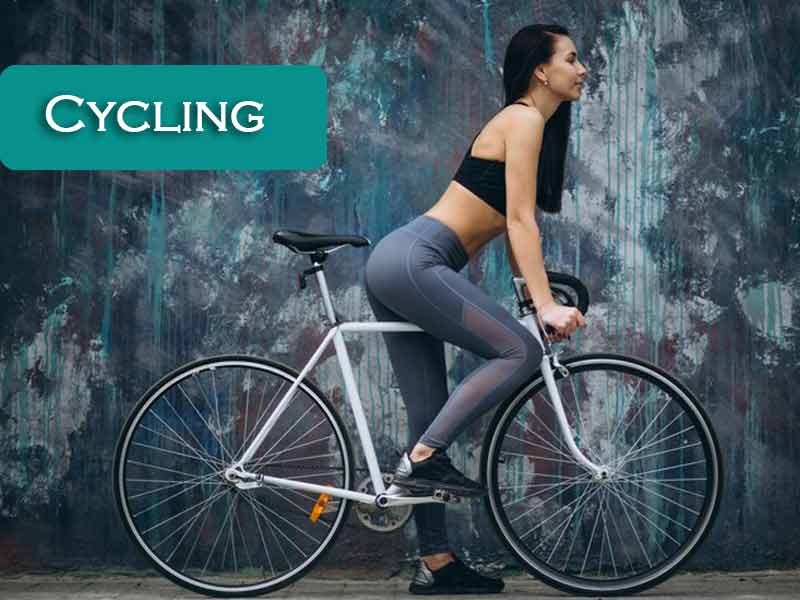Cycling is an excellent form of exercise that has a range of physical and mental health benefits. Whether you’re an experienced cyclist or just starting out, cycling can be a great way to improve your fitness, boost your mood, and enjoy the outdoors. In this article, we’ll explore the benefits of cycling, how to get started, and some tips for making the most of your cycling workout.
Benefits of Cycling
Cycling is a low-impact form of exercise that offers a range of physical and mental health benefits.

Here are some of the top benefits of this exercise:
- Cardiovascular Health: This exercise is a great way to improve your cardiovascular health. Cycling can help reduce your risk of heart disease, lower your blood pressure, and improve your overall fitness.
- Weight Loss: This exercise is a great way to burn calories and lose weight. Cycling can help you burn up to 600 calories an hour, making it an effective way to achieve weight loss goals.
- Improved Mental Health: This exercise is a great way to reduce stress and improve your mental health. This exercise can help release endorphins, which are natural mood-boosters, and can help reduce anxiety and depression.
- Improved Joint Health: This exercise is a low-impact exercise that is easy on the joints. This exercise can help improve joint mobility, reduce joint pain, and prevent joint degeneration.
- Improved Muscle Strength: This exercise is an excellent way to improve muscle strength, especially in the lower body. This exercise can help strengthen your glutes, quads, and hamstrings, which can improve your balance and stability.
How to Get Started
Getting started with cycling is easy. Here are some tips for getting started:
- Choose the Right Bike: The right bike is essential for a comfortable and effective cycling workout. Choose a bike that fits your body type, riding style, and fitness level.
- Gear Up: Wear comfortable and breathable clothing that is appropriate for the weather. Wear a helmet and gloves for safety.
- Start Slow: Start with shorter rides and gradually increase your distance and intensity.
- Find a Group: Join a cycling group or club to meet other cyclists and get support and motivation.
- Invest in Accessories: Invest in cycling accessories such as a water bottle, bike lock, and repair kit.
Tips for a Great Cycling Workout
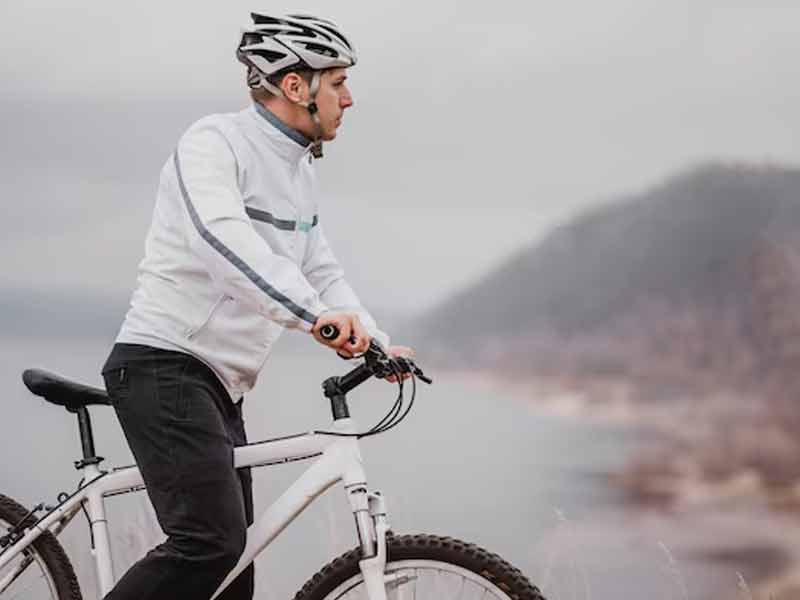
Here are some tips for making the most of your cycling workout:
- Set Goals: Set goals for your cycling workout, such as distance, speed, or time. This can help keep you motivated and focused.
- Vary Your Terrain: Vary your terrain to challenge your body and prevent boredom. Mix up your routes with hills, flat roads, and off-road trails.
- Use Proper Form: Use proper form to maximize your workout and prevent injury. Keep your back straight, your shoulders relaxed, and your elbows slightly bent.
- Use Resistance: Use resistance to increase the intensity of your workout. You can use resistance by changing gears, riding uphill, or using a resistance trainer.
- Listen to Your Body: Listen to your body and adjust your workout as needed. If you feel pain or discomfort, slow down or take a break.
Sample Program about Cycling for beginners

- hoose the Right Bike The first step to getting started in cycling is selecting the right bike. The type of bike you need will depend on the type of this exercise you plan on doing. Road bikes are great for speed and long distances, while mountain bikes are ideal for off-road terrain.
- Get the Right Gear In addition to a bike, you’ll also need the proper gear. A helmet is a must-have, as are gloves to protect your hands and padded shorts to cushion your bottom. This exercise shoes with cleats that clip into the pedals can also make a big difference in your performance.
- Start Slow When you’re just getting started in this exercise, it’s important to start slow. Begin with short rides and gradually increase the length and intensity of your rides as you build up your endurance.
- Focus on Technique Proper cycling technique can help you ride more efficiently and avoid injuries. Make sure your posture is upright, your arms are relaxed, and your pedaling motion is smooth and even.
- Stay Hydrated of this exercise can be a sweaty activity, so it’s important to stay hydrated. Make sure you bring plenty of water with you on your rides and take frequent breaks to rehydrate.
- Find a Group to Ride With this exercise can be a great way to socialize and make new friends. Look for local cycling clubs or groups to join and ride with. You can also use online resources like Strava to connect with other cyclists in your area.
- Set Goals Setting goals can help keep you motivated and focused. Whether you’re working towards completing a specific distance or time goal, having a clear objective in mind can help you stay on track and make progress.
- Learn Basic Maintenance Learning basic bike maintenance can save you time and money in the long run. Familiarize yourself with basic repairs like fixing a flat tire or adjusting your brakes so you can make quick fixes on the go.
- Listen to Your Body It’s important to listen to your body and take rest days when needed. This exercise can be a demanding activity, so make sure you’re not pushing yourself too hard and give your body time to recover.
- Have Fun! This exercise should be enjoyable, so make sure you’re having fun. Experiment with different routes and types of cycling to keep things interesting and enjoyable.
Types of Cycling exercise
There are several types of cycling exercises that you can try, depending on your fitness goals and preferences.
Here are some of the most common types of this exercises:
Road cycling
Road cycling is a type of exercise that involves cycling on paved roads, often for longer distances and at higher speeds. It is a great way to build endurance, cardiovascular fitness, and leg strength.

Here’s a more detailed explanation of what road cycling involves:
Equipment: To start road cycling, you will need a road bike. Road bikes are designed for speed and efficiency, with thin tires and lightweight frames. They are built for riding on paved roads and can handle high speeds and long distances. You will also need a helmet, cycling shoes, and other basic gear like padded shorts and gloves.
Riding technique: Road cycling requires a certain level of riding technique to be efficient and safe. It’s important to maintain an upright posture, with your back straight and your shoulders relaxed. You should also focus on a smooth pedaling motion, using your glutes and hamstrings to power your pedal stroke. Additionally, you should learn how to shift gears to maintain a steady cadence and adjust your effort level as needed.
Training: To get the most out of road cycling, you will need to train regularly. This involves building up your endurance and strength over time by gradually increasing the length and intensity of your rides. It’s important to balance hard efforts with rest days to avoid overtraining and injuries. You can also incorporate interval training, hill repeats, and other specific workouts to target different aspects of your fitness.
Safety: Road cycling can be a dangerous activity if proper safety measures are not followed. Always wear a helmet, use hand signals to communicate with other cyclists and drivers, and follow traffic laws and regulations. It’s also a good idea to ride with a group or at least let someone know your planned route and expected return time.
Community: Road cycling can be a great way to connect with other cyclists and build a community. Joining a local this exercise club or group can provide support, motivation, and camaraderie, as well as opportunities to participate in group rides, races, and events.
Overall, road cycling is a challenging but rewarding form of exercise that can improve your physical fitness, mental health, and overall wellbeing. With the right equipment, technique, training, safety measures, and community support, you can enjoy the many benefits of road cycling.
Mountain biking
Mountain biking is a type of exercise that involves cycling on off-road terrain, such as trails, hills, and mountains. It is a great way to build strength, endurance, balance, and agility while enjoying the great outdoors.
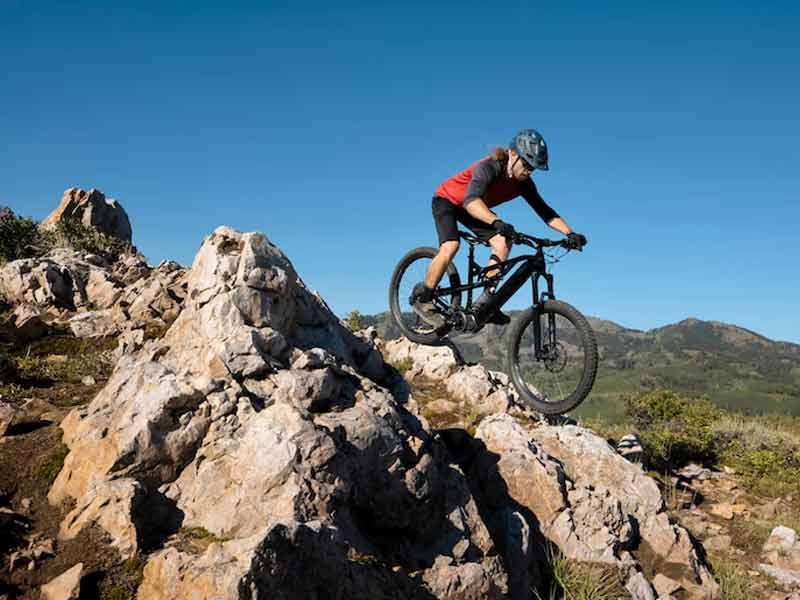
Here’s a more detailed explanation of what mountain biking involves:
Equipment: To start mountain biking, you will need a mountain bike. Mountain bikes are designed for rugged terrain and have features like wide tires, suspension systems, and disc brakes to handle rocks, roots, and other obstacles. You will also need a helmet, cycling shoes, and other protective gear like knee pads and elbow pads.
Riding technique: Mountain biking requires a different level of riding technique compared to road cycling. You need to be able to handle uneven terrain, steep hills, and tight turns while maintaining your balance and control. It’s important to keep your weight centered over the bike, using your arms and legs to absorb shock and maintain traction. You should also be able to shift gears to maintain a steady cadence and adjust your effort level as needed.
Training: To get the most out of mountain biking, you will need to train regularly. This involves building up your endurance and strength over time by gradually increasing the length and difficulty of your rides. It’s important to balance hard efforts with rest days to avoid overtraining and injuries. You can also incorporate specific workouts like hill repeats and technical skill drills to improve your performance on the trails.
Safety: Mountain biking can be a risky activity if proper safety measures are not followed. Always wear a helmet and other protective gear, use hand signals to communicate with other riders, and follow trail etiquette and regulations. It’s also a good idea to ride with a group or at least let someone know your planned route and expected return time.
Community: Mountain biking can be a great way to connect with other riders and build a community. Joining a local mountain biking club or group can provide support, motivation, and camaraderie, as well as opportunities to participate in group rides, races, and events.
Overall, mountain biking is a challenging but exhilarating form of exercise that can improve your physical fitness, mental health, and overall wellbeing. With the right equipment, technique, training, safety measures, and community support, you can enjoy the many benefits of mountain biking while exploring the beauty of nature.
Indoor cycling
Indoor cycling, also known as spinning, is a type of exercise that involves cycling on a stationary bike in an indoor setting, such as a gym or fitness studio. It is a great way to build cardiovascular fitness, leg strength, and endurance in a controlled environment.
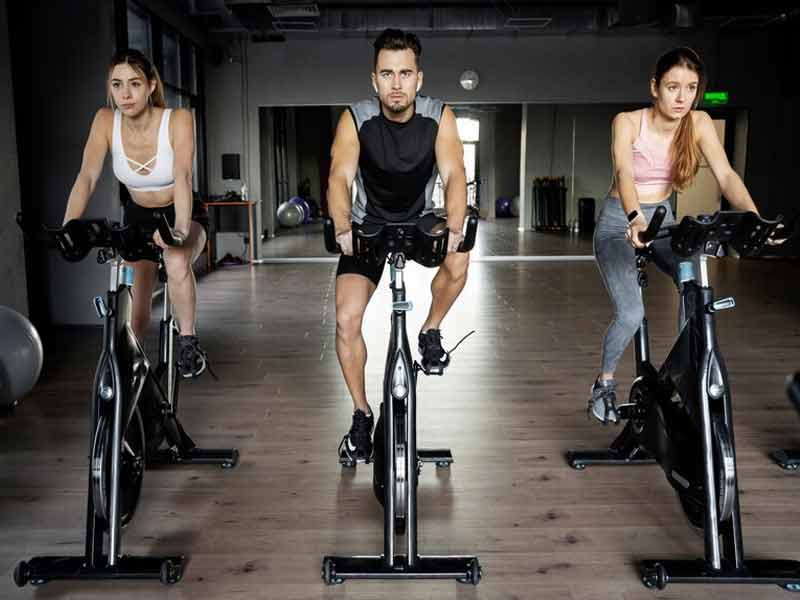
Here’s a more detailed explanation of what indoor cycling involves:
Equipment: To start indoor cycling, you will need a stationary bike. These bikes are specifically designed for indoor use and have features like adjustable resistance, handlebars, and pedals with straps or clip-in cleats. You will also need cycling shoes or sneakers, comfortable workout clothes, and a water bottle.
Riding technique: Indoor cycling requires a specific riding technique to be efficient and safe. It’s important to maintain a proper posture, with your back straight and your core engaged. You should also focus on a smooth pedaling motion, using your glutes and hamstrings to power your pedal stroke. Additionally, you should learn how to adjust the resistance to maintain a steady cadence and adjust your effort level as needed.
Training: To get the most out of indoor cycling, you will need to train regularly. This involves building up your endurance and strength over time by gradually increasing the duration and intensity of your rides. You can also incorporate interval training, hill climbs, and other specific workouts to target different aspects of your fitness.

Safety: Indoor cycling is generally a safe activity, but it’s still important to follow proper safety measures. Always adjust the bike to your height and comfort level, use hand signals to communicate with the instructor or other riders, and stay hydrated during the workout. Healthy dinner ideas and definitions with over 10 recipes
Community: Indoor cycling can be a great way to connect with other riders and build a community. Many gyms and fitness studios offer group classes, which can provide support, motivation, and camaraderie, as well as opportunities to push yourself and reach new fitness goals.
Overall, indoor cycling is a challenging but low-impact form of exercise that can improve your physical fitness, mental health, and overall wellbeing. With the right equipment, technique, training, safety measures, and community support, you can enjoy the many benefits of indoor cycling all year round.
Commuting cycling
Commuting cycling is a form of exercise that involves using a bike as a mode of transportation to get to work, school, or other destinations. It is a practical and eco-friendly way to incorporate physical activity into your daily routine while avoiding traffic congestion and parking fees.

Here’s a more detailed explanation of what commuting cycling involves:
Equipment: To start commuting of this exercise, you will need a bike that is suitable for the type of terrain you will be riding on. This can include a road bike, a hybrid bike, or a commuter bike that has features like fenders, lights, and a rack for carrying your belongings. You will also need a helmet, cycling shoes, and other safety gear like reflective clothing and a bell or horn.
Riding technique: Commuting cycling requires a different level of riding technique compared to recreational cycling. You need to be able to navigate traffic, stop at intersections, and ride in a straight line while maintaining your balance and control. It’s important to follow traffic laws and signals, stay visible to other road users, and communicate with hand signals or a bell when necessary.
Training: To get the most out of commuting cycling, you will need to build up your endurance and strength over time by gradually increasing the distance and frequency of your rides. You can also incorporate specific workouts like hill climbs and interval training to improve your performance and fitness.
Safety: Commuting cycling can be a safe and enjoyable activity if proper safety measures are followed. Always wear a helmet and other protective gear, use hand signals to communicate with other road users, and follow traffic laws and signals. It’s also a good idea to ride with traffic flow, stay visible, and use a bike lane or designated cycling route if available.
Community: Commuting cycling can be a great way to connect with other riders and build a community. Joining a local cycling club or advocacy group can provide support, motivation, and advocacy for cycling infrastructure and policies. The Best tips for beginners in cookery over 30 items
Overall, commuting cycling is a practical and healthy form of exercise that can improve your physical fitness, mental health, and overall wellbeing. With the right equipment, technique, training, safety measures, and community support, you can enjoy the many benefits of commuting this exercise while reducing your carbon footprint and saving money on transportation.
Recreational cycling
Recreational cycling is a form of exercise that involves cycling for leisure or pleasure. It can be done on a variety of terrains, from flat and paved roads to more challenging mountain trails. It’s a fun and social activity that can be enjoyed alone or with friends and family.
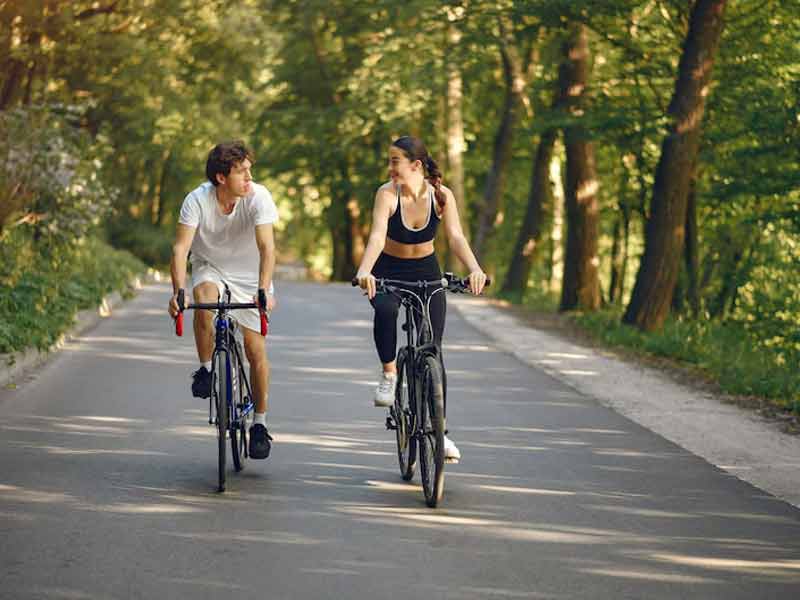
Here’s a more detailed explanation of what recreational cycling involves:
Equipment: To start recreational this exercise, you will need a bike that is suitable for the type of terrain you will be riding on. This can include a road bike, a mountain bike, or a hybrid bike that has features like wide tires and suspension. You will also need a helmet, cycling shoes, and other safety gear like reflective clothing and a bell or horn.
Riding technique: Recreational cycling can be done at a variety of speeds and intensities, depending on your preferences and fitness level. It’s important to maintain a proper posture, with your back straight and your core engaged. You should also focus on a smooth pedaling motion, using your glutes and hamstrings to power your pedal stroke. Additionally, you should learn how to shift gears to maintain a steady cadence and adjust your effort level as needed.
Training: To get the most out of recreational cycling, you will need to build up your endurance and strength over time by gradually increasing the distance and intensity of your rides. You can also incorporate specific workouts like hill climbs and interval training to improve your performance and fitness.
Safety: Recreational cycling can be a safe and enjoyable activity if proper safety measures are followed. Always wear a helmet and other protective gear, use hand signals to communicate with other road users, and stay visible to other riders and drivers. It’s also a good idea to ride with a group or at least one other person and carry essential equipment such as a repair kit and a fully charged phone.
Community: Recreational cycling can be a great way to connect with other riders and build a community. Joining a local this exercise club or advocacy group can provide support, motivation, and advocacy for cycling infrastructure and policies. The benefits of onion and 8 best reasons to use it
Overall, recreational cycling is a fun and healthy form of exercise that can improve your physical fitness, mental health, and overall wellbeing. With the right equipment, technique, training, safety measures, and community support, you can enjoy the many benefits of recreational cycling while exploring new places, meeting new people, and challenging yourself.
Time trial cycling
Time trial cycling is a type of cycling exercise that involves racing against the clock on a flat, straight course or a looped circuit. It is a highly competitive and intense form of cycling, requiring a high level of fitness, technique, and mental focus.
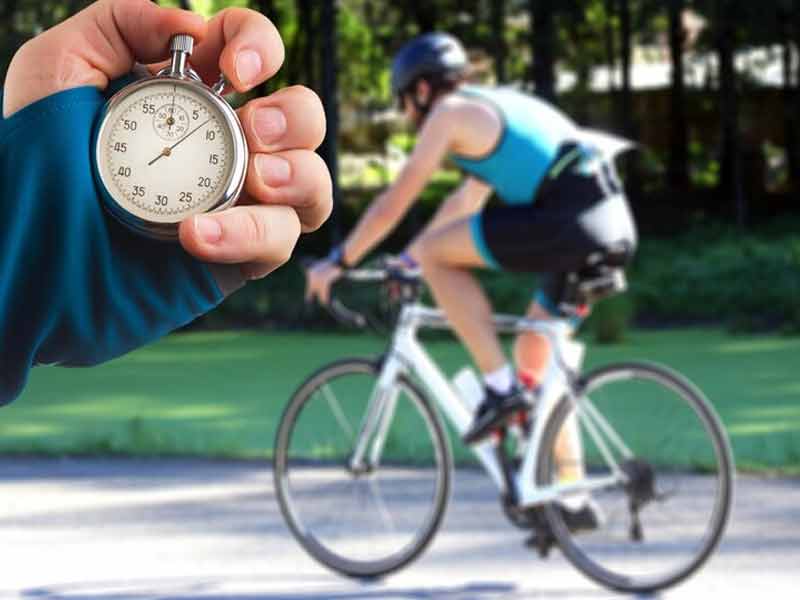
Here’s a more detailed explanation of what time trial cycling involves:
Equipment: To start time trial cycling, you will need a bike that is specifically designed for speed and aerodynamics. This can include a time trial bike or a road bike with aerodynamic features like deep-rimmed wheels, an aerodynamic frame, and handlebars that allow for a more aerodynamic riding position. You will also need a helmet, this exercise shoes, and other safety gear like reflective clothing.
Riding technique: Time trial this exercise requires a different level of riding technique compared to other forms of this exercise. You need to be able to maintain a consistent and high speed over a long period of time, while maintaining a smooth pedaling motion and an aerodynamic riding position. It’s important to focus on proper breathing, cadence, and power output, as well as maintaining control and stability while cornering at high speeds.
Training: To excel at time trial this exercise, you will need to build up your endurance and speed over time by gradually increasing the distance and intensity of your rides. You can also incorporate specific workouts like interval training, hill climbs, and high-intensity intervals to improve your performance and fitness.
Racing: Time trial cycling is typically done in a race format, with riders starting at intervals and racing against the clock. The rider with the fastest time over the course wins. Races can range from local club events to national and international competitions.
Safety: Time trial cycling can be a safe and enjoyable activity if proper safety measures are followed. Always wear a helmet and other protective gear, use hand signals to communicate with other riders, and follow traffic laws and signals. It’s also important to maintain control and stability at high speeds, and to be aware of other riders and obstacles on the course.
Overall, time trial cycling is a highly competitive and challenging form of exercise that can improve your physical fitness, mental toughness, and overall wellbeing. With the right equipment, technique, training, and safety measures, you can enjoy the thrill and excitement of time trial this exercise while pushing yourself to new levels of performance and achievement.
No matter which type of this exercise you choose, make sure to wear appropriate safety gear, such as a helmet and reflective clothing, and follow traffic laws and safety guidelines.
Conclusion
Cycling is a great way to improve your physical and mental health. Cycling offers a range of benefits, including improved cardiovascular health, weight loss, improved joint health, improved muscle strength, and improved mental health. Getting started with this exercise is easy, and there are many tips and tricks for making the most of your cycling workout. Whether you’re an experienced cyclist or just starting out, this exercise is an excellent form of exercise that can help you achieve your fitness goals and improve your overall health and well-being.
The last word is with you, the audience
Be sure to read other educational articles. For scientific issues, be sure to contact a specialist doctor. These materials are only for study and non-educational purposes. Of course, expert doctors can guide you a lot.
Our cooking training center has collected unique materials for you dear ones. This content is very useful and will help you cook the best and most delicious food for yourself and your loved ones at home.
The recipe section is for introducing the best dishes of the nations. Dear ones, you can see the best dishes in this section and cook whatever you want at home. Don’t forget to read the recipe and ingredients before doing anything to determine your cooking needs.
Soon we will be with you with a more professional team with more facilities. We suggest that if you are overweight, fill out the and wait for our experts to contact you and send you the right meal plan.
The slogan we put on our site is to fight obesity. In this regard, we will provide you with many suitable recipes. Be sure to follow our site to learn about many healthy foods. Do not forget that a healthy life requires extensive changes. One of these changes is changing food. So eat healthy
Please follow us on linkedin. You can learn all best french food recipe and best Italian food recipe and best arabic food recipes and best Iranian food recipes you can check our Reddit page.
